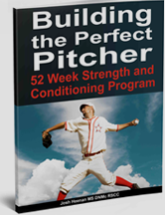Progressing the Reverse Lunge for Improved Performance
Guest post written by Brian Donofrio, C.S.C.S.
When working with athletes (especially our baseball guys), I’ve found the reverse lunge to be one of the best bang for your buck exercises we do in the weight room. It’s great for teaching proper loading of the hips, core control through the sagittal, frontal and transverse planes, as well as building stability, strength and power in a lunge pattern. And the carry over to sport is huge. Whether the athlete is running, throwing, or swinging, developing both stability and strength in the reverse lunge will lead to huge success. And through proper progressions and coaching of the reverse lunge, we can set our guys up to be stronger, faster and more powerful athletes.



Once an athlete successfully learns how to complete a reverse lunge, the benefits are huge. Getting to that point, though, requires allocating the time needed to build a strong foundation for the athlete to be successful in the movement. I’ll go over how exactly we attack the reverse lunge and how we get our guys into great positions that lead to success on the field.
When teaching a reverse lunge, or any exercise for that matter, you need to perfect the athlete’s baseline for the movement before you can progress them and start loading it. For some advanced lifters, you might be able to show them a proper reverse lunge a few times and they immediately crush it. But more often than not we need to start from the ground up, and work our way to performing the reverse lunge.
½ Kneeling Position
For most of our guys, this baseline means just getting them into a perfect ½ kneeling position on the ground. We teach them to have a good amount of dorsiflexion and a positive shin angle in the front leg. In the trail leg we look for full hip extension, and the back ankle dorsiflexed with the toes driving into the ground. We get them set up with the ribs down with the chest tall, neck back and chin tucked. The basic cues we use are to engage the core, feel the hips, and drive the toe into the ground. Here they can understand where we want them to feel tension through lower level activation. It also gives us the benefit of using kinesthetic cues to get the athletes exactly where we want them to be and give them more points of contact to reference and stabilize from. We might also incorporate some thoracic rotational work or overhead reaching in this position to train more dynamic stabilization in the position before moving forward. This allows the athlete to get a basic understanding of positioning and gain a kinesthetic sense for the position we’re asking them to get into.


Split Squat Hold
The next progression is to have the athlete perform a split squat hold (the bottom position of the reverse lunge). We’re looking for similar position as in the ½ kneeling position, except now the back knee is just off the ground, removing a point of contact to the ground. This makes it a more demanding position to be in and further challenges the athlete to build stability in the unilateral pattern. We’ll also incorporate proper breathing techniques to get them more comfortable in this position and improve their ability to hold it for a longer period of time. We typically like to work an athlete up to the point where they can hold that position for about 2 minutes/side. Just like with the ½ kneeling position, adding in rotational work or overhead reaching increases the transference to the field in terms of dynamic stabilization requirements.


Split Squat
Once the athlete is successful with the split squat hold, we can move on to a full split squat. Start with the athlete standing upright, with front and trail leg about 1 stride length apart with feet at hip width. The athlete then descends into the bottom position (the split squat hold described above). We have the athlete briefly pause here before driving back up. The key for carry over to the reverse lunge is to focus on the eccentric and isometric portion of the movement. This helps engrain the pattern and improves the athlete’s kinesthetic sense throughout. To further load this movement we may use a KB in a goblet or unilateral/bilateral front grip hold, a barbell in the front or back position or a safety bar to increase the demand of the tissues and further challenge the stability demands.
Reverse Lunge
As the athlete successfully completes the split squat, with the end positions and movement pattern performed to our standards, we can then start utilizing the reverse lunge in training. The athlete stands tall, with feet even about hip width apart. We’ll start by having the athlete take a step back and sink into the bottom position, holding there for a set amount of time.
The big cue here is to load the hips through the decent, building up tension and force to transfer through the ground on the concentric portion of the lift. We progress with a slight pause at the bottom followed by a powerful drive to the starting position. I coach my athletes to drive at an angle, using the hips to move forward to the starting position as if they are throwing a baseball to home plate or sprinting away from the line of scrimmage towards the end zone. We look to see that the athlete can maintain an upright position in the torso, and is able to stay balanced through the motion without leaning to one side or the other. Make sure the athlete is stabilizing through the core the for the entire lift, which is apparent if they can keep their weight shifted forward rather than swaying back in the bottom position or as they begin the concentric portion of the lift.
As the athlete becomes successful with the movement, we can load it in a number of ways, from a goblet hold with a kettlebell to a safety bar to a barbell. As long as they maintain good positioning and movement pattern, we can really challenge our athletes here.
Summary
If you want your athletes to keep progressing in the weight room, then you have to ensure they master the basics before attempting more complex movements. Give them the framework of proper position and movement patterns in more foundational exercises, and you can see a huge carry over. By establishing a strong foundation through positioning and proper progression, we set our athletes up for success not only in the weight room but on the field. Take time perfecting the basics, and the benefits will be huge for your athletes.
About the Author
 Brian is a strength coach based out of Advanced Therapy and Performance in Stamford, CT. He trains athletes from the high school to professional level, drawing upon his experiences in athletic performance and rehabilitation. He has worked extensively with collegiate athletics at his alma mater, the University of Connecticut, where he earned his B.S. in Exercise Science. After graduation, he worked with UConn Football Strength and Conditioning, as well as with a number of the school’s D1 athletic programs, including Men’s Soccer and Men’s Track and Field, as an undergrad. Brian holds his CSCS through the NSCA. You can find Brian on Instagram or at advancedtherapyperformance.com
Brian is a strength coach based out of Advanced Therapy and Performance in Stamford, CT. He trains athletes from the high school to professional level, drawing upon his experiences in athletic performance and rehabilitation. He has worked extensively with collegiate athletics at his alma mater, the University of Connecticut, where he earned his B.S. in Exercise Science. After graduation, he worked with UConn Football Strength and Conditioning, as well as with a number of the school’s D1 athletic programs, including Men’s Soccer and Men’s Track and Field, as an undergrad. Brian holds his CSCS through the NSCA. You can find Brian on Instagram or at advancedtherapyperformance.com











Leave a Reply